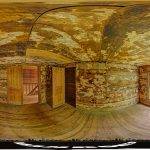The Fascinating History of the Grabowsee Sanatorium
Explore the intriguing and desolate beauty of the Grabowsee Sanatorium in Germany through an immersive experience with our virtual tours. Picture yourself standing in the heart of this abandoned facility, where every turn offers a new perspective of its haunting charm. As you embark on a 360-degree exploration, the intricate details of the crumbling walls, the echoes of history in the silent hallways, and the serene yet eerie atmosphere of the surrounding nature come alive. These tours provide a unique opportunity to delve into the sanatorium’s past, uncovering its stories and secrets from the comfort of your home. Witness the interplay of light and shadow, the contrast of nature reclaiming the man-made structures, and feel the essence of this once-bustling medical facility now standing still in time. This virtual journey promises a captivating experience, inviting you to unravel the mysteries of the Grabowsee Sanatorium, a place where time seems to have stood still.
Image by: Jürgen Schwörer
Image by: Detlev Molitor (Business View Photo Ag)
Image by: Detlev Molitor (Business View Photo Ag)
Image by: Detlev Molitor (Business View Photo Ag)
Image by: Tim Peix
Image by: Tim Peix
About the Abandoned Grabowsee Sanatorium
The Grabowsee sanatorium, nestled in the serene backdrop of Lake Grabow in Germany, presents a captivating tale of medical innovation, historical shifts, and eventual abandonment. Here’s a comprehensive exploration of its intriguing history:
Founding and Construction of the Grabowsee Sanatorium
In the late 19th century, pulmonary tuberculosis was rampant in the German Reich. The Red Cross’s “People’s Health Resorts Association” acquired land near Lake Grabow to test whether the air in the North German Plain could successfully treat lung diseases, a hypothesis contrary to the prevailing belief that only mountain or Mediterranean climates were beneficial. The test’s success led to the establishment of the first sanatorium for lungs in northern Germany, the Grabowsee sanatorium, in 1896. Initially, the facility comprised 27 barracks, but by 1900 it evolved into a more permanent establishment with 200 beds for patients with varying degrees of illness.
Operations and Expansions
The sanatorium was initially exclusively for men and featured patient houses, operating theatres, treatment rooms, and an underground transport system for food delivery. During World War I, it served as a Red Cross hospital for lung-diseased soldiers and housed prisoners of war until 1918. After the war, the economic hardship led to its sale in 1920 to the State Insurance Institution Brandenburg, who expanded the facility to around 420 beds by the 1930s.
Unique Features and Facilities
The sanatorium boasted innovative features, including an underground electric “meal train” for food transportation, an internal phone system, electric clocks, radio speakers, and a unique coffin elevator for discreetly moving the deceased to a nearby chapel. The facility, despite its remote location, managed sewage and electricity independently, using an underground pipe network and acetylene gas storage and generators.
Decline and Closure
The discovery of antibiotics in the 1940s made long-term hospital stays for tuberculosis unnecessary, rendering many sanatoriums, including Grabowsee, superfluous. Post-World War II, it was utilized by the Soviet military as a hospital until 1995. The facility’s maintenance declined significantly during this period, and after the Russian forces withdrew, a new, viable use for the site couldn’t be established without substantial investment.
Present State and Use of the Grabowsee Sanatorium
Today, the Grabowsee sanatorium lies in a state of picturesque decay, a shadow of its former self, plagued by vandalism and metal theft. However, since 2005, the association “Kids Globe e. V.” has been taking care of the site, with 15 buildings under monument protection. The site has been used for educational events, films, and photography, attracting both historians and artists. In 2007, the chapel was destroyed in an arson attack, and in 2013, educational events for young people started. The site has also been a popular location for movies, such as ‘Monuments Men’ and ‘Heilstätten’.
Conclusion
The Grabowsee sanatorium’s story is a poignant reminder of the ever-changing tides of medical history and societal needs. From a groundbreaking healthcare facility to a cinematic backdrop, it has transitioned through various phases, mirroring the evolution of both medical science and historical events. Its current state of disrepair serves as a haunting yet beautiful testament to its rich and varied past.
If you liked reading about this abandoned sanatorium, you might like the Charles A. Cannon Jr. Memorial Hospital in North Carolina, the Medical and Sanitary Unit 126 in Pripyat, or the Larundel Mental Asylum in Australia.

A 360-degree panoramic image inside one of the rooms at the Grabowsee sanatorium in Germany. Image by: Detlev Molitor (Business View Photo Ag)
Do you have 360-degree panoramic images captured in an abandoned location? Send your images to Abandonedin360@gmail.com. If you choose to go out and do some urban exploring in your town, here are some safety tips before you head out on your Urbex adventure.
Unlock the secrets of exploration by diving into precise GPS data available exclusively for an array of hidden gems and hundreds of other captivating sites, all within our members’ section. By investing in a Gold Membership, you’re not just gaining access; you’re securing a key to a vast, global archive of abandoned, untouched, and mysterious locations waiting to be discovered. Embark on your adventure with confidence, knowing every corner of the world can be within your reach. Don’t just observe—explore, discover, and claim the extraordinary journey that lies ahead with our treasure trove of world secrets. Subscribe now and transform the way you see the world!
If you want to start shooting 360-degree panoramic images, you might want to look onto one-click 360-degree action cameras.
Click on a state below and explore the top abandoned places for urban exploring in that state.






